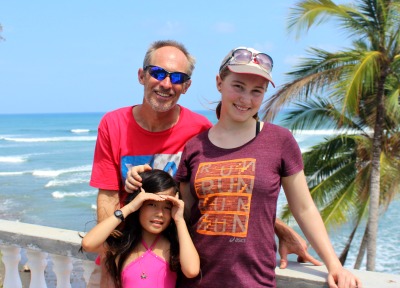
We were on our way to visit our friend Juancho at Mono Feliz.
Shawn and Shena were just putting the final touches on their surf/stand up paddle board camp.
It was spectacular. Shawn was out paddle boarding when we arrived. Shena was hanging out with their 2 kids.
We ended up staying for much longer than we intended. It was a very comfortable place and we all had a great time sitting around and chatting.
The aerial video below was taken of and around Burica Surf. It was taken before our visit. As you will see the main building is still under construction. The water and conditions look sweet.
[leadplayer_vid id="588EA3DE25B69"]
You can find various wave opportunities for both beginning and advanced surfers, as well as for beginning and expert stand up paddle (SUP) boarders. You can rent a board at Burica Surf for $20/day.
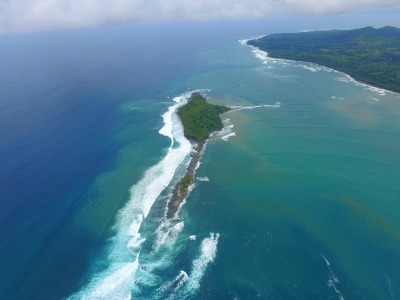
You can also paddle out to Burica Island (or Isla Burica) in about 25 minutes. It can be leisurely circumnavigated in an afternoon.
My husband has enjoyed surfing at Burica Island before and wrote about it.
Burica surf is at the very tip of Punta Burica. It is in a remote area with views of Burica island.
It is about a 1-1/2 hour drive from the beach town of Puerto Armuelles.
From Puerto Armuelles, every hour there are small buses to the village of Bella Vista. (These buses stop after 6pm.) Bella Vista is about 2.5 kilometers from Burica Surf. Which means it will take you about 30 minutes on foot or 15 minutes by car to get to Burica Surf from Bella Vista.
If you want, you can ask the Burica Surf folk to come and pick you up at the airport in David or in Paso Canoas. Paso Canoas is the town at the border between Panama and Costa Rica.
For detailed directions to get to Punta Burica & Burica Surf, visit our Punta Burica hotels page.
Now the accommodations are even nicer than when we visited. Check out the photo below of their main building. I downloaded it off their website, buricasurf.com.
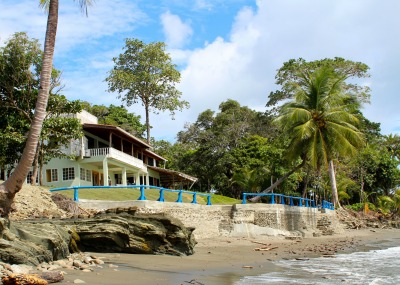
Rooms
Lodgings at Burica Surf are rustic, yet comfortable.
There is no electricity or Internet. Which means it really is a wonderful nature retreat without distractions.
They have 4 rooms and 3 dorms.
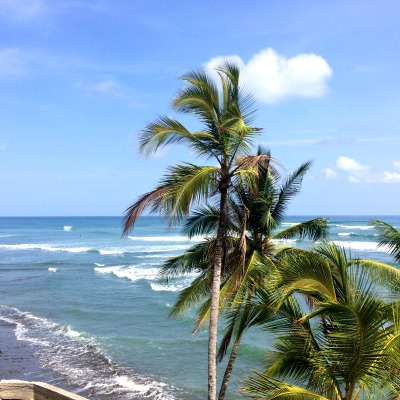
Food
Meals are available for purchase. It is only $30 a day (3 meals).
All meals are served in a “family” style in the upstairs dining area overlooking the surf breaks.
To reserve your accommodations, you must pay a 50% deposit.
You can cancel your reservation within 24 hours of booking your accommodations.
They offer group rate and package deals.
Electronic bank transfer, Pay Pal, and cash (USD).
You are welcome to show up without a reservation, but then they can only accept a cash payment. (Remember there is no internet or electricity at Burica Surf)
You can find out more, including their contact information, at their website: BuricaSurf.com.
If you make it out there I'm pretty sure you will have a fun and relaxing time.
As Shawn says, "There's always something to ride!"
Please let me know how you liked your visit there. Comment below.
[leadplayer_vid id="58506DB07FEED"]
If you are interested in visiting Mono Feliz, visit their facebook page for more information. I have also written about Mono Feliz on my site.
You can visit Mono Feliz via a road (which is soon to be paved most of the way) or, my favorite way, by driving on the beach. You must time your journey with the tides.
We have visited Mono Feliz from Puerto Armuelles both as a day trip and for multiple nights.
You can learn more about Puerto Armuelles starting here.
Betsy: Hi, it was a lot of fun stumbling across this video is of us back in 2007.
It gives you a relaxing glimpse of life in Panama
It's a little baby monkey, she's 4 months old,called Niña, a howler monkey.
We're at Mono Feliz in Panama, Punta Burica.
Reyn: We're relaxing and the stresses of daily life.
Our house is actually being sprayed for termites,as we speak, so we had to vacate it for the weekend.
They sprayed it with a mix of diesel and ariva, which is a commercial crop dusting chemical, so that's all going in our house so it'd be nice to let it air out for the entire weekend before we go home and sleep there.
We're here at Mono Feliz,there are small waves at the surf camp down the way
and Steve and another tourist and I were gonna try those out, so that will be fun.
Skylar: Look, look dad.
Reyn: I'm very happy and relaxed here.
It's cool.
(child laughs)
I think the monkey can actually hang by his tail.
Betsy: He's too young.
Reyn: This one is a huérfano.
Betsy: Let's say goodbye to Niña.
Bye, bye Niña, little scratcher.
Reyn: Want to compare size of hand?
music ♫ Can you hear it calling, Come on down to Panama

“When I grow up,” Paul proclaimed, “I am going to build myself a house out of trash”.
(FYI - He never did build a house of trash. He teaches painting at Penn State)
I certainly wasn’t interested in living in a house made out of trash. It sounded kind of, well, trashy.
That was in 1979.
Fast forward 30 years, and nobody calls it “trash” any more.
Today we use the terms “recycled material” or “Post Consumer” material. We’re all building out of recycled materials, whether we realize it or not.
The fact is that many parts of our homes are made out of “trash” today. Thank goodness for recycling.
With 7 billion people living on the earth, and with the continued promotion of the “American Dream” (ie, a high consumption, high environmental cost, standard of living) there is going to be an ever greater need to get creative about using recyclables in home construction.
In Seattle, where our family is from, many creative remodelers and builders visit the Boeing Aviation Surplus Store to find such crazy building products as aluminum honeycomb fusilage, or solid aluminum bar stock “I-Beams”, and you name it. It’s pretty high tech stuff, but it appeals to a certain type of designer builder.
For instance, on an loft apartment/art studio project in which I participated, our crew used aluminum honeycomb panel fuselage material as the floor in a sleeping loft. Aside from being super cool to look at, since the hexagonal cells of the honeycomb were visible on the exterior sheet surface, the material was so rigid that it required no structural supports, other than the perimeter walls. Obviously this material calls for a different approach to building (ie, practically no framing support). This results in a very clean, ultra modern look. It wasn’t a look that I particularly liked for a human dwelling. It wasn’t traditional, cozy, or “homey”. Rather, it was “defiant”, “impervious”, “edgy”. It certainly challenged the viewer’s normal sense of what constitutes a home.
Of course, you can also find much more traditional recycled building materials in Seattle. There are many, many recycled building supply centers in Seattle, as there are in most metropolitan areas of North America. You can find old fir warehouse beams, recycled bowling ally floors, stained glass from old churches, antique bar mirrors and surrounds from 120 year old hotels.
When one comes to Panama, one doesn’t think about recycling. Most buildings are pretty new and made of cement.
However, Puerto Armuelles is unique here. What we have is a company town, former home of Chiquita Banana Company. “The Company” as it was known, imported most of the materials used to build the town of Puerto Armuelles, literally from the ground up.
If you have ever get the chance to explore inside an old Chiquita Banana house, up on stilts, you will surely discover lumber stamps from Portland, Oregon where this gorgeous, old-growth red cedar was milled well over half a century ago.
If you know anything about lumber, then you also know that the quality of the 2”x4”, 2”x6, 2”x8” framing material, as well as the 8”x8” and 8”x 10” support posts and beams is of such standard that has not been available as building material in North America for decades.
If one purchased it in the states today, the wood in the old Chiquita Banana Houses would be considered “furniture grade” and probably cost in the $15-$25 range per board foot—prohibitive for home building. I wouldn’t be surprised if our own house in Las Palmas contained over $50k worth of clear, old growth cedar.
If you look at the tightness of the growth rings, you will see that none of these trees could have been younger than 1000 years old. I love this beautiful old wood. Still, I’d much rather see the wood in the forest than in my house.
In addition to clear, old growth cedar, some of the more recent vintage Chiquita Banana Houses are built using the identical plan as the original Chiquita houses.
However, the newer models, dating from 25, 35, even forty years ago, are built from other exquisite woods. That is, these houses are built of dimensional lumber logged directly from the jungles (now, former jungles) of our own Punta Burica.
Just as the original Chiquita houses were built of ancient Cedar trees, so the newer generations of Chiquita houses are built of local, but equally ancient forest trees. Species such as Teak, Sangrio, Espave, Kirra, etc. A couple of these woods, particularly teak have very good resistance to termites. Sangrio and Kirra are gorgeous furniture quality hardwoods that are really too hard to be good framing material. They require pre-drilling, prior to sinking a nail.
As for the logic of cutting down a 10 foot diameter ancient rain forest tree in our local jungle just to make an 8”x8” structural post or beam in a Banana Company house, some of us have different views. I suppose back in the days of Chiquita Banana in Puerto Armuelles, nobody ever thought that the world would ever run out of wood. If you are from Canada, it might seem that there is still an endless supply of old growth trees.
I am not suggesting that one purchase Chiquita Banana houses and begin disassembling them and loading them into containers for export. But, rather, I am saying that there is a huge quantity of amazing building material available for those who are on a tight budget, but who have creative energy to burn.
Many of the original Chiquita Banana houses have fallen into disrepair. Since the local builders have a strong preference for building with concrete, many of these Chiquita houses just get scrapped, or used as concrete form boards.
A thorough search in the various neighborhoods of Puerto Armuelles would surely turn up some excellent salvage. I am guessing that one could purchase adequate salvage material from old Chiquita Banana houses to build an amazing beach house, for a couple to 5 thousand dollars.
This includes studs, joists, cedar siding, and super heavy duty galvanized roofing. There are still even a few old Chiquita hand washing sinks and toilets floating around in town.
I do not want to contradict what I said earlier about wood not being a desirable building material in our coastal/tropical climate. I stand by that opinion, if you are building a conventional house, using conventional methods and utilizing the labor force available in Puerto Armuelles at the present time.
Find out more, by reading why you shouldn't build with wood in Panama and why remodeling a wood home is not the best idea.
However, if you are artistic, high energy, and want to build something super inexpensive, something that is truly unique, and truly yours, building with Chiquita salvage could be ideal.
I think you might be able to come to Puerto Armuelles, buy a bargain priced lot for under $5k, and put up a completed structure, made primarily of recycled Chiquita Banana surplus.
The final product would be limited only by your own skill and imagination. This entire home could be built for well under $5k (total price for house and land under $10k).
Obviously, this sort of a challenge, and this kind of lifestyle, is not for everyone. However, if this sort of thing sounds like a fun adventure to you, you have come to the right place. Puerto Armuelles is a great place to experience this sort of an “alternative” eco- building lifestyle.
I have only mentioned Chiquita wood salvage so far, but Chiquita Banana imported other great materials as well. For instance, you will notice shortly after arriving in Puerto Armuelles, that many of the local fence posts are made from railroad rail, salvaged (stolen?) from the narrow gauge Chiquita Banana railroad tracks.
These tracks ran from the banana fields all the way to the shipping pier in downtown Puerto Armuelles. The train also ran to David. Some folks have reused this rail to build house posts, beams, storage buildings, hoists, racks, etc…
Imagine a practically unlimited supply of railroad rail. If this starts your mind thinking of possible projects, then you are the person I was hoping to communicate with in this article.
In addition to railroad rail, Chiquita imported miles of steel plumbing pipe, as well as some super thick walled steel tube section, both round and square.
Some of this material is still being sold just for its scrap iron weight. However, the salvage market is certainly getting more competitive, as materials prices go up. However, it depends on how good a scavenger you are.
If I could show some of this Chiquita Banana salvage to my friends from architecture school, they would probably have heart attacks. All this salvage, and very few people who have the design skill to take advantage of it.
If you have any questions about recycled Chiquita Banana building products, or about alternative building methods, in general, please contact us. We are always happy to share with you what we know, and we are eager to learn anything that you might be willing to share
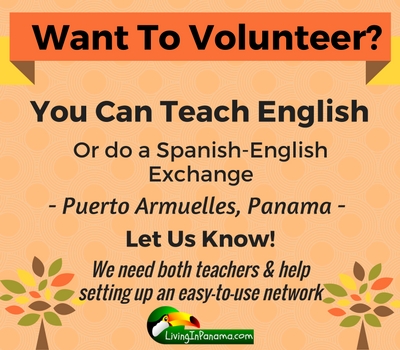
Or possibly an English-Spanish exchange network.
It would be a way for expat retirees to help young people in Puerto Armuelles improve their English.
As you can imagine, there are many more job and business opportunities open to Panamanians who speak English. It literally opens many doors for them here and internationally.
In Panama, where there is a wide gap between the upper class and the poor, helping a young person of modest means to improve their English skills might be the jumpstart they need to launch them, and their family, from the lower class into Panama’s growing middle class.
You really can make a difference in your world by volunteering to help another person. It is a satisfying way to maintain a grateful heart.
Not only is volunteering is a great way for expats to mix with locals, it is a an ideal way to practice your Spanish. And, of course, there is always the possibility of working out a trade: English lessons for Spanish lessons.
What’s more, you just might make a new friend for life. Who knows?
I am trying to get a rough idea of how many of our readers might be interested in participating in a language volunteer, or language exchange project. If you know someone who may be interested in volunteering, please let them know about our idea.
Is there anyone with a great organizational gift who would like to help with the logistics of setting up an easy-to-use system?
Please let us know. Send us an email, use our contact page, or comment below.
We welcome your suggestions, since this is new territory for us.
Thanks.
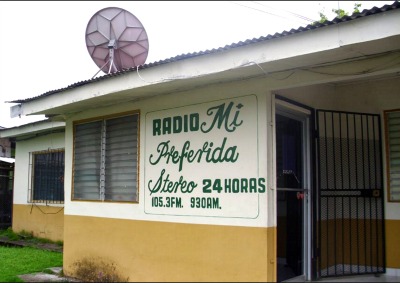
UPDATE - The radio show is currently paused (June 2016)
Recent transplants to Puerto Armuelles, Michael Butler and Beverley McAleese, have undertaken a new adventure. They will be hosting a weekly program at our local radio station “Radio Mi Preferida” (located behind Romero’s).
It is fun that our town is small enough, and simple enough, that you can still make a proposal for a radio program, do the necessary research for the show, find a way to cover costs (I am sure contributions will be welcome. Betsy and I have already pledged to contribute), and get the program on the air.
What is amazing is that in our little town of Puerto Armuelles, one of the co-anchors of the new radio show, Michael Butler, has 45 years of broadcast journalism experience in the private sector and with the CBC in Toronto, Ontario.
Michael’s roles in radio have included research, writing, and reading the news live on the air nightly. He has also produced newscasts for television that have aired nationally in Canada. He has interviewed presidents and prime ministers, beauty pageant winners and punk rockers. He even covered the 1976 Montreal Winter Olympics.
Michael’s wife and co-anchor of the new show, Beverley McAleese has a diverse background indeed. However, professional social work, and being of service to others, are a thread that runs throughout her career. Among Beverley’s social service projects have been working with battered women and women and their infants recovering from addictions, and creating a program for prostituted and trafficked women. Beverley received a Toronto YWCA Woman of Distinction Award in recognition of her career of service to the public.
While we are not familiar with the details of the upcoming radio show, Michael and Beverley have indicated that their half hour show, which airs each Wednesday at 4:30 PM, will touch on matters of spiritual significance, but without being Christian-focused, or reflecting the views of any particular belief structure or organization.
The topic of our spirituality, while living in an apparently carefree place like Puerto Armuelles, Panama is, no doubt, of significance to all of the expats here. Some of us have gotten together to discuss, or at least we are highly aware of, the challenges that arise when one makes the big decision to pick up stakes and move to Panama, only to discover that, just because we live in “paradise”, doesn’t mean that our lives are paradisical.
Ultimately, we all have to confront the same basic challenges that we faced before, in our “old lives” wherever it was that we were living. In fact, a number of Puerto Armuelles ex-pat residents have lived in a tropical paradise before, in Costa Rica, or elsewhere in the tropics. What on earth could cause one to leave paradise and move to another paradise ?(other than taking a bite of that forbidden apple, or mango)? My guess is that if the first paradise didn’t solve the problem, then the second (or third, or fourth) paradise is not going to do it either.
If none of this applies to you, congratulations, (I would like to read your book). However, if you are like most of us, then you are a “work in progress”, and you can probably learn something useful from Michael’s and Beverley’s program. Or call in, or email in something useful to add to the conversation.
I wrote abit about spiritual life in Panama in this post.
You can listen online or on an old school radio.
The radio station is Radio Mi Preferida Estero at 105.3 FM or 930 AM
Visit the radio station's website to listen online.
It's a weekly show on Wednesdays from 4:30 to 5pm.
Their first show is this coming Wednesday, May 4, 2016
I am sure they would appreciate you listening.
I don't know if you can contact them during the show, but if you can, the radio booth phone number is 770-7408.
Break a leg Beverley and Michael!
And thanks for taking on this new adventure.
[leadplayer_vid id="57261D0B32748"]
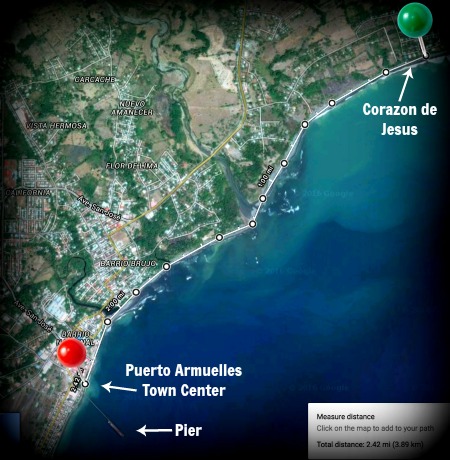
I had been thinking of doing it for awhile, but I finally shook off my laziness and did it. And I took my daughter along for the ride.
We are both happy we did it.
According to Google, it is 2.42 miles from the Corazon de Jesus neighborhood to downtown Puerto Armuelles.
I cannot tell you how long it took since we stopped so very often, but I'm thinking if you were a little more focused on your destination you could do it in about 40 minutes.
March 26, 2016 by Skylar Vayda and Betsy Czark
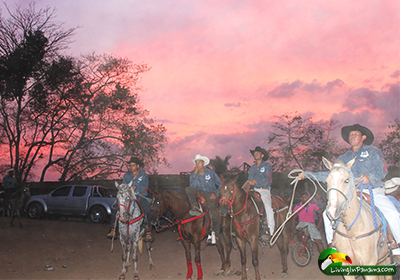
The Rodeo, or Pista de Lasso (as it is called in Panama) consists of lasso teams competing to lasso a calf in the shortest time possible. And definitely under 20 seconds, which is the maximum amount of time a cowboy has to lasso a calf within an 80 meter long space.
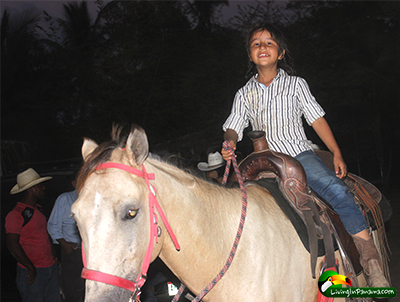
The rodeo begins at 11 am and goes into the evening. Because of this time frame, as the day progresses, some teams perform more poorly than others because one or more of their riders is drunk.
The rodeo's atmosphere is lively and at time intense, as the supporters of each team shout their encouragements. There is also a fair amount of unofficial bets being placed, so that may be something to look out for.
My (Skylar's) past experiences at the rodeo have been wonderful. I loved horses when I was younger. Because of that I especially enjoyed seeing the pure breed horses outfitted in their colorful harnesses. I went often when I was younger. I even owned my own lasso so I could practice. But I watched much more lassoing than I practiced.
The rodeo season is a large part of the culture in Panama. While in Panama you should definitely experience it at least once.
Puerto's Rodeo Schedule
Rodeos occur on 8 consecutive Sundays. The first rodeo was on March 6th.
The Pista de Lasso technically start at 10am, but usually don't get going until 11ish. Food and drinks are sold at the events.
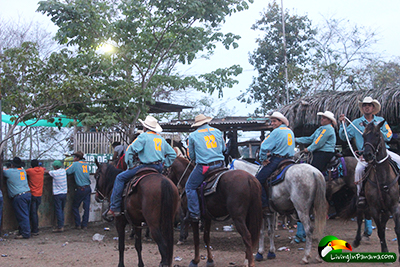
5 Remaining Competitions
March 27 - Location outside of Puerto Armuelles
April 3rd - Casa de Puma - located about 3 miles from downtown Puerto
April 10th - Location outside of Puerto Armuelles
April 17th - Romero Arena in Altos San Vicente neighborhood
April 24 - Location outside of Puerto Armuelles
There are a total of 10 teams competing in these rodeos. Four are from Puerto Armuelles. One of those teams is sponsored by 2 Puerto Armuelles expats & horse lovers: Veronica and Tony.
Do you want to be part of a team? You cannot just join, you must be invited. The teams are really clubs. To show your interest and prowess, you must go to the practice roping events that are held from November - February.
I will be updating this post soon. I want to impart the wealth of information about these events from Veronica and Tony.
I simply don’t have time to write it up now. But I wanted to get the rodeo schedule to folks in case they want to attend. Last Sunday, Skylar and I enjoyed ourselves at the rodeo in Altos San Vicente. The photos on this page are from that day.
Update: During Panama's coronavirus quarantine, no one is allowed to leave their house on Sundays, including Easter Sunday. Easter 2020 will be very different throughout the world. For those missing community this day, reach out to family and services online. My family is doing a group zoom call on Easter. Your church is likely conducting services online. A Google search will uncover more services and ways to connect. Keep healthy!
It is one of the most popular and celebrated holidays in Panama.
Semana Santa starts on Palm Sunday and ends 7 days later on Easter/Pascua Sunday.
During the weekdays of Semana Santa, the celebrations are noticeable solemn and religious in nature.
But on Holy Saturday and Easter Sunday, only the more religious remain solemn.
For the majority of people, all solemnity is shed on Saturday, esp. Saturday night, and on Sunday.
Come the weekend, spending the day at the beach, clubbing and drinking become the more popular activities. Of course, the powers that be encourage solemnity by banning alcohol sales from Thursday thru Saturday. (For more on alcohol & other bans, read further down.)
Easter is also the last holiday for 6 months in Panama. This could explain why the week-long holiday ends more in a party mode rather than in a solemn religious fervor.
The next holiday is in November. To make up for that 6-month long hiatus, the month of November celebrates 5 holidays.
Semana Santa also often marks the end of summer or the dry season. The rainy season usually begins in late April or in May.
Discover more about Panama's climate and weather.
As I've indicated, Holy Week is a time for special masses, local religious processions dedicated to Mary, Jesus, a Saint, Jesus's last supper, crucifixion, or resurrection.
Every day of the week commemorates different things. I describe the most significant days below.
Palm Sunday - Celebrates Jesus’s return to Jerusalem after his 40-day fast in the desert. His followers laid down palm leaves before him to walk upon.
You won't see that. But you are likely to see people walking around with palms or palms woven into crosses after they leave the church on Palm Sunday.
Holy Wednesday - Church services typically include the reciting of the stations of the cross. Some churches put on a Passion of Christ play (aka Easter Pageant) to dramatically depict the stations of the cross. (Passion in this context means suffering).
The Stations of the Cross: There are 14 stations which represent various milestones of Jesus's last week of life (Holy Week). The first is of Jesus being sentenced to death by Pontius Pilate and the last is of Jesus being laid in his rock-hewn tomb.
Maundy Thursday - Commemorates Jesus's Last Supper and the command he conveyed to his disciples during the meal:
"A new commandment I give to you, that you love one another: just as I have loved you, you also are to love one another" (John 13:34).
For me, this command to love one another is the most important and essential element of Semana Santa.
Some churches have silent processions on this day while others hold reenactments of Jesus's journey carrying the cross. (Note: Maundy is a shortened form of the Latin word mandatum, which means command.)
Good Friday - Commemorates the crucifixion of Jesus Christ. All across Panama, you will find somber and religious processions to commemorate this event.
Some processions have floats, some visit the stations of the cross that parishioners have constructed in various locations on the procession circuit, and some do both.
Whether you are a believer, a photographer, or simply curious, you will find a Good Friday procession in almost every Panamanian town.
Below are photos of people gathering for the Good Friday procession to visit each of the stations of the cross which were created in various neighborhoods.
These photos were taken in Puerto Armuelles, Panama. The photos of the stations of the cross were taken in the day, before the procession. Click on any photo to start the slide show.
Holy Saturday - This is a day in which Jesus was is in his tomb. There is not much to reenact or do with around that. However, as the photo shows, not everyone goes to the beach.
Easter/Pascua Sunday - Big celebration of the resurrection of Christ. The day he rose from the dead. In the States, that is the big day for believers to attend church.
On Easter day in Panama, mass is held, of course. However, in Panama, believers are more likely to attend church multiple times earlier in the week.
The date of Easter changes each year. It can occur anytime from February through April. The exact dates vary in accordance with the lunar calendar.
The following are prohibited from noon on Maundy Thursday thru 6pm on Holy Saturday:
If you want to have a drink during those 54 dry hours, you should purchase your alcoholic beverages before noon on Maundy Thursday.
Like all big holidays in Panama, people pour out of Panama City to go back “home” and then they flood back again. If you can avoid it, do not travel from Panama City into the interior on Wednesday or Thursday or in the reverse direction on Sunday.
Keep in mind, during Easter, Carnival and other big exodus holidays, the government tends to turn the Pan-American highway by Panama City into a reversible lane highway. Which means, trafffic will only be allowed to exit Panama City at the beginning of the holiday. Then when everyone heads back to the city to go to work, the section of the highway near Panama City will only allow city-bound traffic. Check the news before you travel.
Everyone gets a four-day weekend. There are 3 public holidays during Holy Week: Maundy Thursday, Good Friday, and Holy Saturday. Most people also get a half day off on Holy Wednesday too. Mostly, because nobody's mind is on the job before this big family holiday so their employers just send them home.
You will find all government offices and many establishments closed during this 4 to 5 day weekend.
There are a number of foods that are special for the week of Semana Santa.
This article is long enough, so I write about Panama's Easter foods in a different post.
In the last few years, you can find easter decorations and related items in Panama.
But it is not prevalent or even found in all places in Panama. If you are searching for something as specialized as a chocolate Easter bunny, your best options will be found in Panama City or in places where there are a number of expats.
If you want to participate in an egg hunt, your best option may be to host one yourself.
My kids grew up in Panama, creating a more American-like Easter is a challenge. When we first came, I could not even find food coloring to use to dye our eggs. Turned out it was fun to discover our own dyes. We love dying eggs in my family.
To find out what we do, see my article on how on expat kids celebrate Easter in Panama.
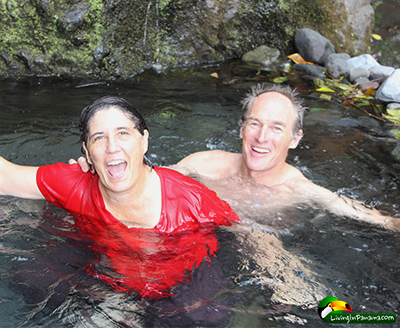
You can see us playing in the river (Rio Macho de Monte) as it runs through the canyon.
The trip reminded me how small and easy it is to explore Panama, and Chiriqui Province in particular.
Business & Pleasure
We wanted to go play in this cool mountain river (see photos), but we also had to meet with a lawyer in David. So we combined the trip.
Day Trip
Home - Beach - City - Mountains - Home again
After Reyn and I returned from our morning surf/boogie board at the beach, all four of us piled in the car. We left Puerto Armuelles at around 10am. We drove to David to meet with the lawyer.
Then we decided to drive past the canon turn off, and go all the up to Volcan to eat lunch. We like the food at Restaurante Mana at the Volcan Lodge. A 15 mile round-trip detour.
After filling our bellies, we went back down to the little village of Cuesta de Piedra, where you turn off to go to Canon Macho de Monte. (I describe how to get there at the bottom of this page and I show what it is like there in photos below.)
We had a delightful and leisurely time playing in the water and boulder hopping. Then we headed back to Puerto Armuelles. We got home before dark (It gets dark around 7pm these days). A very eventful, fun, and even productive day trip.
I had been wanting to check out this canyon for awhile. From the road it is a short walk to the canyon bottom. The trickiest part is that a huge hill of sandy gravel shares the path down, so it is a bit slippery.
In the slow part of the river there were tadpoles that my kids enjoyed catching. A pool to dunk yourself in. Boulders to hop to get to the fissure where the water runs faster and cascades down even further. People have secured a rope right there so you can play in the rapidly tumbling water, but I loved dunking myself in the cold water. Now that I have gone, I want to come back in the rainy season.
The photos below were taken towards the end of the dry season (mid-March). I look forward to going back in the rainy season. I am sure the water flow is much more dramatic and exhilarating.
Take the road up to Volcan. You turn off the InterAmericana onto the Volcan road at the town of Bugaba. There is a sign marking it on the InterAmericana. The turn off for the Canon is at the tiny village of Cuesta Piedra, about 7.5 miles or 12 kilometers south of Volcan.
If you are heading north (or uphill) towards Volcan, there is a sign marking the turn for Canon Macho de Monte in Cuesta Piedra. No such luck if you are heading down from Volcan. The turn is at an intersection with a gas station (photo below) and a few other commercial buildings. You can only turn one way. There is no road going the other direction.
I have put photos below of some key places to look for so you know where to turn, park, and walk.
You will drive on that road for less than 3 kilometers. Look for the guard house for the hydroelectric plant. It will be on your right, as you head down a hill. As you down that hill you will see a ruin of a building on your left (see photo below). Park there. Then walk down the road and take the trail (see photo) just before you cross the bridge over Rio Macho de Monte. As I've said, the trickiest part of the short walk to the canyon bottom is that a huge hill of sandy gravel shares the path down. It is a bit slippery. It is a short walk.
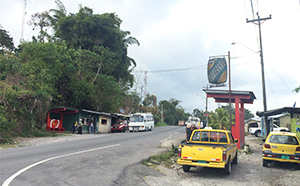
Reyn describes day trips from Puerto Armuelles in a past post. He talks about going for hikes in Cerro Punta.
